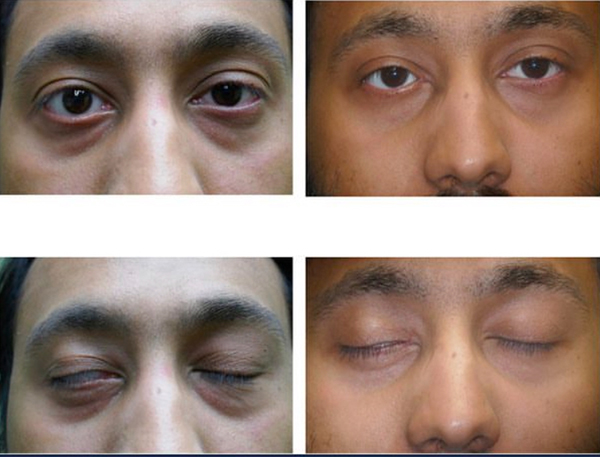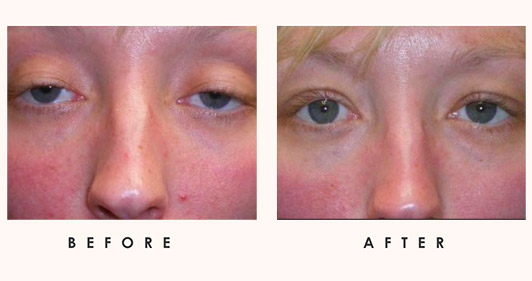Ptosis
Jump To

Definition
Ptosis is an abnormally low position of the upper eyelid that involves weakening muscles that cause droopiness. The drooping may possibly be worse after being awake longer, when the individual’s muscles are tired. This condition is frequently called “lazy eye”. If severe enough and left untreated, the drooping eyelid can cause other conditions, such as amblyopia or astigmatism. This is why it is especially important for this disorder to be treated in children at a young age, before it can interfere with vision development.
More specifically, Ptosis occurs when the muscles that raise the eyelid (levator and Müller’s muscles) are not strong enough to do so mechanically. It can affect one eye or both eyes and occurs more frequently in the elderly, as muscles in the eyelids may possibly begin to deteriorate. Ptosis can be caused by the apneurosis of the levator muscle, nerve abnormalities, trauma, inflammation or lesions of the lid or orbit. It can also result from myogenic, neurogenic, aponeurotic, mechanical or traumatic cause and can also be associated with other conditions (immunological, degenerative, or hereditary disorders, tumors, or infections). While acquired ptosis is most commonly caused by aponeurotic ptosis, congenital neurogenic ptosis is believed to be caused by the Horner syndrome.
What Is the Difference Between Blepharoplasty and Ptosis?
Many patients come to us with complaints of looking tired or disinterested. Others visit our office because their droopy eyelids are impacting their vision. There are two different conditions that can cause this: weakening of the upper eyelid tendons; laxity of upper eyelid skin. Idaho Eyelid and Facial Plastic Surgery has two methods of fixing these issues. Our surgeons tighten the muscles/tendons is ptosis repair, or remove excess skin through blepharoplasty. There are instances where patients might need both a blepharoplasty and ptosis repair when they have excess skin AND weakened tendons.
Congenital Ptosis
Congenital ptosis is the presence of a droopy eyelid or eyelids since birth. It can be unilateral or bilateral. Although it is not always recognized in newborns, it usually becomes more noticeable within a few months. Ptosis can be mild, when the lid partially covers the pupil, or severe, when the lid completely covers the pupil. There is usually a higher position of the ptotic eyelid on downgaze. While the cause of congenital ptosis is often unclear, the most common reason is improper development of the levator muscle. The levator muscle is the major muscle responsible for elevating the upper eyelid. The condition of congenital ptosis is often associated with anisometropia, strabismus and amblyopia, refractive errors, astigmatism, or blurred vision. Drooping eyelids can result in undesirable facial appearance. Moreover, those with significant ptosis sometimes need to tilt their head back into a chin-up position, lift their eyelid with a finger, or raise their eyebrows in an effort to see from under their drooping eyelid(s). This also applies to adults who have not had surgical repair.
Congenital ptosis is most often treated by ophthalmic plastic and reconstructive surgeons who specialize in disease and conditions affecting the eyelids, lacrimal (tear) system, the orbit (bone cavity around the eye), and adjacent facial structures. At Idaho Eyelid and Facial Plastic Surgery, our ptosis patients will undergo a complete ophthalmic exam with particular attention to visual acuity and motility. Congenital ptosis is treated surgically, with the specific operation based on the severity of the ptosis and the strength of the levator muscle. If the ptosis is not severe, surgery is generally performed when the child is between 3 and 5 years of age (the “pre-school” years). However, when the ptosis interferes with the child’s vision, surgery is performed at an earlier age to allow proper visual development. The surgical procedure is determined by the amount of levator function present and the severity of ptosis. Function is typically categorized as poor (less than 4 mm), fair (5 to 7 mm) and good (more than 8 mm). In cases of severe ptosis in less than 2 mm of levator function, suspension of the lid to frontalis muscle is the procedure of choice.

Marcus-Gunn Jaw-winking Ptosis
In 1883, Marcus Gunn reported an unusual type of congenital ptosis with a peculiar movement of the affected lid. Marcus-Gunn jaw-winking ptosis is a rare condition when a patient’s eyelids involuntarily lifts/winks when they move their jaw. This condition usually results from a congenital nerve misfiring and causes eyelids to react to movement of the jaw. It does not generally improve with time, but adults/children do tend to learn how to minimize the appearance through modifying their facial expressions. Marcus-Gunn jaw-wink ptosis is an example of synkinesis, which is an abnormal innervation connecting two groups of normally unrelated muscles. This phenomenon is thought to be due to a congenital misdirection of the fifth cranial nerve fibers into a branch of the third cranial nerve that supplies levator muscle.



